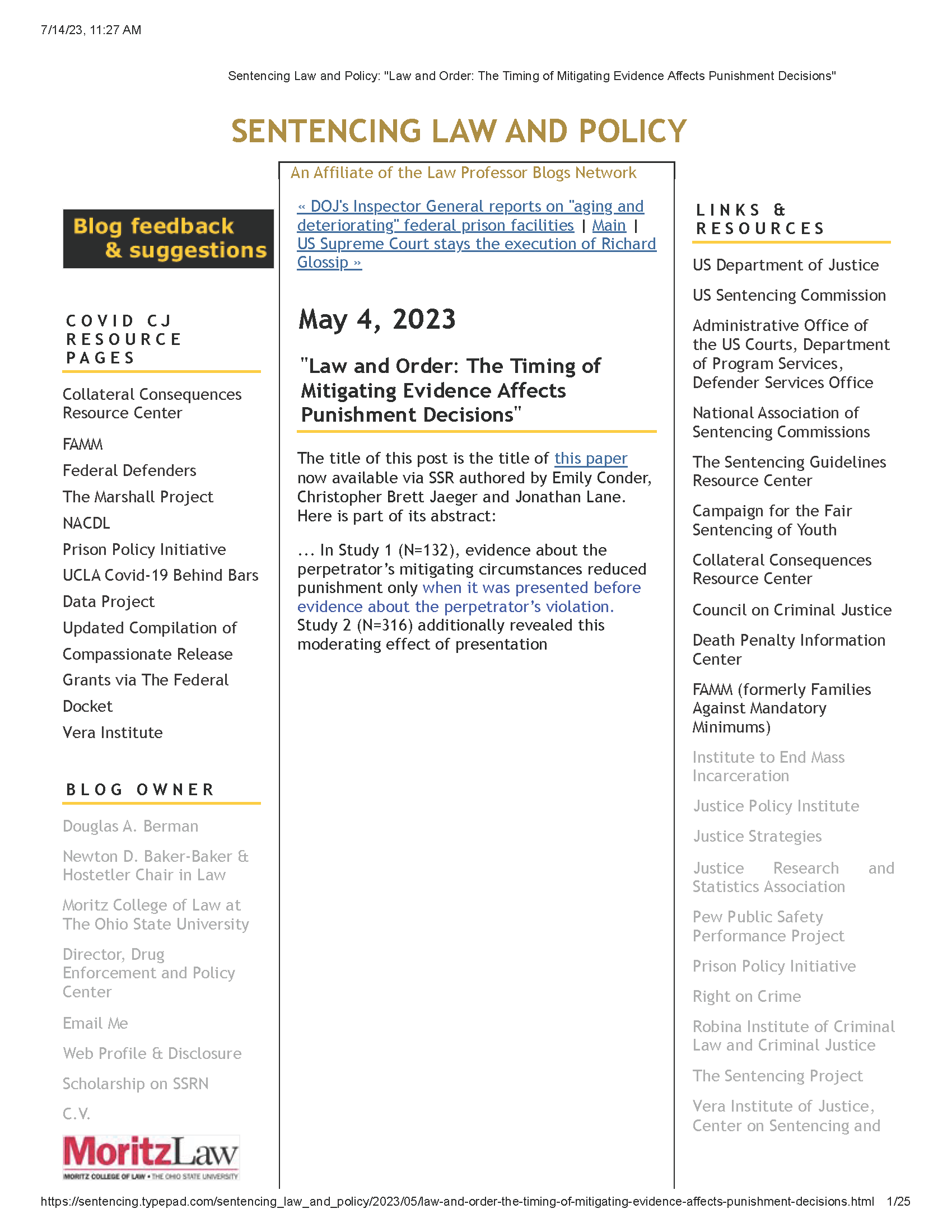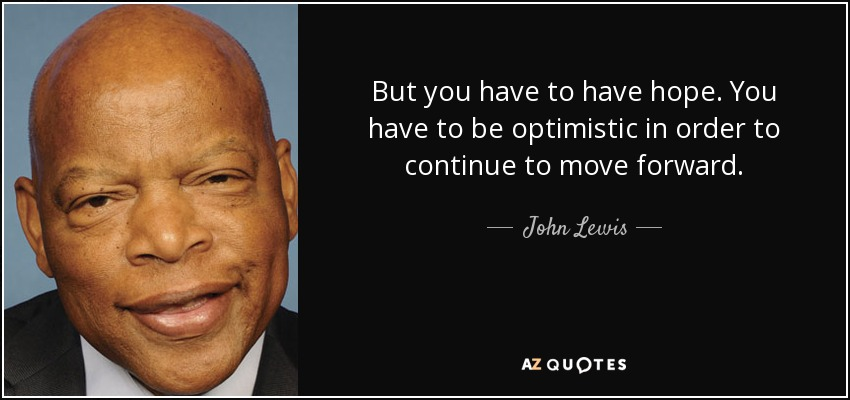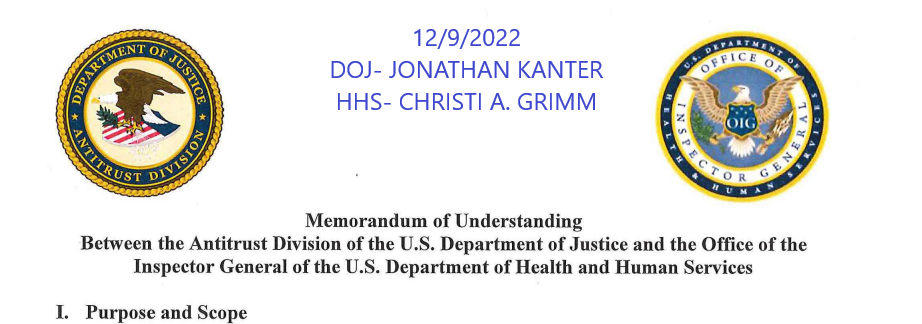YOUR NARRATIVE📜 YOUR STORY, Provided 1-2 Weeks Before The PSI; Helps The Judge Know ‘You’, May🤞Mitigate Their Sentencing Decision
SENTENCING LAW ⚖️AND POLICY.
This study provides more Validation for 👉The Personal NARRATIVE (written by your client, reviewed and guided by those with Mitigation Experience), and then provided to their Probation Officer 1-2 weeks before their Presentence Interview. The included in The Presentence Report is now Under Seal and will be read by all of your future STAKEHOLDERS.
Now your client’s NARRATIVE (with their RELEASE Plan and Letters Attesting to their CHARACTER), becomes part of their Presentence Report-Under Seal. Aside from their INDICTMENT, the Judge can learn ‘who’ the defendant is.
In this Study👇1 (N=132), evidence about the mitigating circumstances reduced punishment only when it was presented before evidence about the perpetrator’s violation, in other words before the Judge, 1st) reads the Presentence Report that just has the DOJ INDICTMENT, without your NARRATIVE, and 2nd) evaluates the Probation Officers sentencing and placement recommendations, solely based of the DOJs INDICTMENT-NARRATIVE of your client.
👉The INDICTMENT.
Your client’s story, seen through the eyes of The DOJ Indictment, makes them look like America’s Most Wanted. If left unchallenged, this will be the story or NARRATIVE of your client that future STAKEHOLDERS will read and believe, starting with the Judge.
Waiting until the sentencing hearing is not acceptable because 1st) all your Judge will know about you is through your INDICTMENT, and 2nd) they usually have a tentative sentence in mind during the week before the hearing – which is based on that same INDICTMENT. See this short Video on Sharing your story.
Judges have agreed that they need your client’s help in understanding ‘the why’, of what happened. They know that crimes do not occur in a vacuum and are interested in what caused the person in front of them to break the law.
‘Stand Out To Your Judge.’ M. Santos interviews Federal Judge Mark Bennett on the importance of writing Your Personal NARRATIVE, including it in Your Presentence Report.
Presenting all of the court-requested Biographical Background, Personal Identification along with your client’s Story or NARRATIVE, and RELEASE Plan 1-2 weeks before their Presentence Interview allows the Probation Officer to learn about your client before they ever meet.
A little effort goes a long way, as these officers each have huge caseloads and no time. So it should come as no surprise that some may actually appreciate the fact that your client came to this meeting prepared and provided all of the information needed before the interview date. This gives the officer time, allowing them to fill out their Probation Report before they ever meet your client, not being rushed.
Then at the interview, the officer can take the time needed to get to know your client personally, coming away from the interview where your client appears the opposite of the person characterized in the INDICTMENT. As these are usually in written format, judges may find viewing a Video a better way to get to know your client’s whole story. These videos can be under 10 minutes and can be taken with a Smartphone if budgets are tight.
👉 Writing your NARRATIVE is an Arduous and Self-Reflective Experience
Make sure your client has Truthtellers✨to support them.
- We All Make Mistakes
- Don’t forget: this is your chance.
- Those around you should bring out something Positive in you.
- This is your client’s autobiography (of their life), the good – the bad, and the ugly.
- Enablers may make you feel good for that moment – but will not 👎🏻 be helpful in the long run. The NARRATIVE is your client’s explanation without excuses, where they have accepted responsibility⚖️ and have remorse for the pain they have caused while not minimizing what has happened.
When writing The NARRATIVE, consider associating your client with those most appropriate and knowledgeable regarding what they will be facing before, during, and after prison. This skill goes beyond the traditional defense and is best provided,
- At the appropriate time (just before or after the guilty verdict in preparation for their PSI),
- Those with the appropriate experience of what their client’s future STAKEHOLDERS will need to see and hear before their interview – during and after incarceration, and as they prepare to ‘successfully’ reenter society.
- The Probation Officer (PSI) and Judge are now their first two STAKEHOLDERS.
👉 CATEGORIES INCLUDED IN THE NARRATIVE.
- Nature and CIRCUMSTANCE: Here, you want to describe,
- Why did you do this?
- How did you get involved?
- What was your involvement?
- You should check that your involvement reflects what is in the final Presentence Report.
2. History and CHARACTERISTICS, Here you want to include,
- Your client’s remorse,
- Your Client’s Accepted Responsibility
- How your client ruined their victim’s lives,
- Traumatic Life event(s) – review with details,
- Show the court what your client’s plan is never to come back,
- Where there was a positive or negative family life – explain this,
- What has this experience taught them? Did it bring up moments from our client’s past?
- Was there a “trigger,” what was that trigger, and how do you remove it from your client’s life?
- Include the good things that your client’s done, explain with examples and letters (at least 10 good ones) that Attest to their Character,
- Show what your client’s doing today to change and improve themself regarding rehabilitation (NA, AA, GA, Therapy, etc.), Community Volunteering, and paying restitution – if they can. This all becomes part of your PSR, now Under Seal.
- Should a Professional License Be lost, include how this will result in the loss of a profession loved, a career, and income. Still looking into other options, incarceration is temporary, and life will go on with strategic and well-thought-out planning.
Consider this short YouTube before writing your NARRATIVE. Simply speaking, this is Your Story or Autobiography. Nike’s Brand is ‘Just Do It’, Tesla’s is Space-X, and your NARRATIVE has to be your story and the experiences that brought you to this point in your life – helping your Judge, understand who you are.
3. FAMILIAL HISTORY: Married – Children – parents’ responsibilities and sole caregiver
4. DEFENDANT’S PHYSICAL CONDITION: Medically documented, bad Back-Hip-Knees-Shoulder along with Tinnitus could provide your client with a Bottom Bunk. Diabetic, Vascular Disease, Raynaylds could allow the Medicare soft shoe or sneakers.
5. MEDICAL/PHYSICAL HEALTH, MENTAL AND EMOTIONAL HEALTH: Include ALL medical records, Labs, Surgery Reports, Diagnostic: X-rays, CT, MRI, Ultrasound, PET scans (in Written, Flashdrive or CD format), Prescriptions for medications (Check Generic Medication Availability), and medical devices, along will All physician contact information. These specific medical needs can be met if included as part of your Medical History;
- Bottom Bunk: Past medical history of Tinnitus, vertigo, or back problems.
- Diabetic Soft Shoes, Sneakers Instead of Rigid Institutional Boots: Past medical history of a torn Achilles heel, knee, or hip issues.
- Being of a certain age / Having weight or having a Hernia issue: could result in getting passes of “no standing for prolonged periods” and “no lifting over 15 pounds,” helping you escape some of the crappier work assignments.
- “Medical idles,” which get you out of everything, are also available, either short or long-term, for various ongoing ailments (ranging from a bad hip to PTSD).
6. SUBSTANCE ABUSE: Alcohol, Drugs (Legal or Illegal), within the previous 12 months before the arrest. RDAP allows up to 1 year off the sentence. They may do a Urine test.
- If you started these programs on your own, before your Presentence Interview or before you were Indicted, MENTION THESE IN THE NARRATIVE, WITH COPIES OF YOUR TREATMENT RECORDS FROM YOUR PROVIDERS (AA, NA, Gambling, or a Sex Therapy Program).
7. EDUCATION AND VOCATIONAL SKILLS: Copied of the highest level; otherwise, a GED will be required in prison. If you have experience with computers, administrators frown on these skills, so you may not want to include these certifications.
- The Second Chance Pell Education Grant. Do you have your GED? Yes, Great! Do you have a College Education? The Department of Education intends to fully implement the legislative changes to allow eligible students in college-in-prison programs to access Federal Pell Grants, beginning July 1, 2023. The Biden-Harris Administration has the following list of participating Colleges and Universities. Please check for Grant eligibility first.
- Your Client Is An Entrepreneur: think about creating a course.
8. MILITARY: Copies, branch, discharge?
9. EMPLOYMENT: The P.O. will check. Judges love a good work record or history.
10. STATEMENT FINANCIAL RECORDS: If there are financial fines/ restitution, Congress and The BOP now strongly encourage participation in their Financial Responsibility Plan in order to benefit from all Earned Time Credits and access to Programming. This is in addition to all other required financial records. Don’t try to hide parts or all of this, as the P.O. may find out, angering the Judge.
👉 WHY YOUR NARRATIVE (AND RELEASE PLAN) IS A CRITICAL COMPONENT OF YOUR 📜 PRESENTENCE REPORT
Taking weeks to months to complete can result in a distilled version of yourself that is honest and pure, where you feel Remorse, Accept Responsibility, and Identify with the Victims of the Crime You Perpetrated.
- If the resulting Narrative or Your Story – is quite the opposite of the DOJ’s Indictment Narrative, where your client sounded like ‘America’s Most Wanted, ‘then your client did a Great Job!
👉 ADDITIONAL COPIES 📑 OF ALL PERSONAL IDENTIFICATION AND BIOGRAPHICAL INFORMATION
1. Divorce Decree
2. Financial Records
3. School Diplomas, Your highest education level completed, Professional Diplomas, and any Trade or Occupational Certification(s).
4. Marriage Certificate
5. Naturalization papers
6. Draft Registration card
7. Car Registration papers
8. Military Discharge certificate
9. Birth or baptismal certificate
9. Immigration papers or passport
10. Employment verification (pay stubs)
11. Character Letters of Recommendation
12. Military Disability information (C-number)
13. Income Tax reports for the last three years (or more if requested)
14. Outstanding Detainers and Immigration Issues Resolved before The Presentence Interview
15. Proof of residence (rent receipts, property, mortgage papers, etc.)
16. Professional papers (COPIES: Social Security Card, Drivers’ License, and Birth Certificate.)
17. Medical Records, Hospital – Surgical – Pathology and Blood Lab Reports, Copies of X-ray, MRI, CT, Ultrasound, PET Scans, EEG, EKG reports (on Flash Drives or CDs), Prescriptions for Medications and Medical Devices.











